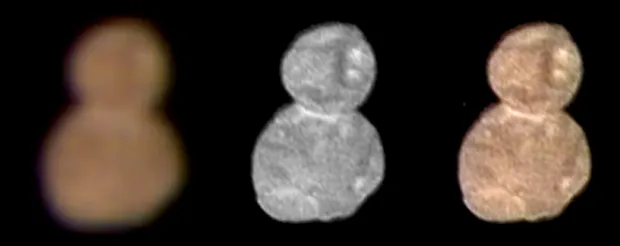The highest definition photo so far of the minor planet Ultima Thule in the Kuiper Belt has arrived from NASA’s New Horizons spacecraft. The probe took a multitude of photos of Ultima Thule, increasing in definition as the gap between them closed, with the highest-resolution images from the moment of closest approach still to come.
The first images to arrive were only a vague blur taken during the approach, leaving its exact shape a mystery: did it look like a bowling pin, or was it perhaps two small objects orbiting each other? This photo, which followed the next day, has revealed the object to be a cluster of two fused objects, a 'contact binary', in the shape of a snowman.
“The two lobes are perfectly separated, which implies that they must have merged extremely gently. Otherwise, they would have shattered,” said Dr Olivier Hainaut, astronomer at the European Southern Observatory. “This is not typical for other parts of the Solar System — look at the craters on the Moon for examples of what usually happens!”
Ultima Thule’s colour, as well as its shape, holds clues to its nature. “The two lobes seem to be of the same colour, and the surfaces seem very uniform,” observes Dr Hainaut. “This is also extremely interesting: this suggests the two lobes are constituted of the same material, and that it is rather homogeneous.”
Even though the flyby took place on 1 January, the images are just starting to trickle in. Ultima Thule is the most distant object ever to be studied in a flyby, so the data has a long way to travel. Ultima Thule itself is 43 times further away from the Earth than the Sun, so it takes over six hours to send a signal back to Earth. That number will only increase as the New Horizons probe travels yet further away.
But more significantly, it will take an astonishing 20 months to receive all of the data from this flyby. The probe transmits data at only one kilobit per second — by comparison, the average broadband download speed in the UK is 46.2 megabits per second, 46,200 times faster than New Horizons.

The New Horizons spacecraft began its voyage in January 2006 on a mission to Pluto. After nine long years of travel, it sailed past the dwarf planet at a narrow distance of 12,500 kilometres, snapping a stunning collection of holiday photos as it passed. As well as capturing Pluto and its moon Charon in colour, New Horizons revealed flowing ice on Pluto’s surface and the heart-shaped region around its equator, Tombaugh Regio.
Once New Horizons passed beyond Pluto, it had enough fuel left for the team to select a new target in the Kuiper Belt. Having recruited the Hubble Space Telescope to search for a new object of interest, the team selected Ultima Thule in late 2015. Since the Kuiper Belt sits far out in the Solar System, with its inner reaches brushing the orbit of Neptune, its inhabitants such as Ultima Thule are known as trans-Neptunian objects (TNOs).
“Because of its orbit and its colour, we believe that it has been preserved in the outer part of the Solar System essentially as it was formed, and has never been disturbed by anything since,” explained Dr Hainaut. “This is not the case for many other TNOs, which have either been ‘implanted’ in the Kuiper Belt by Uranus and Neptune, or have been shuffled around by gravitational interaction with the planets.”
There are very few bodies in the Solar System which have stayed the same over their entire lifetimes. Comets, for example, are affected by the heavy blast of sunlight they receive as they rocket past the Sun. “Observing Ultima Thule is therefore for planetary scientists as exciting as interviewing an Australopithecus for an anthropologist. We are peeking at our most ancient past.”
Follow Science Focus on Twitter, Facebook, Instagram and Flipboard